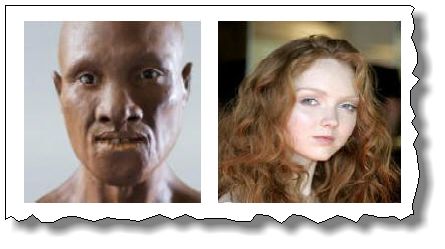GENESIS AND DEVELOPMENT OF THE ARYAN CIVILIZATION

FIRST EUROPEANS WERE BLACK
The first people of Europe were prehistoric Africans. They lived mostly in the southern parts of Europe, and created many paintings and cave art throughout the region. Pretentious scholars struggling with their self-inflicted racist theories attach ill-fitting names to the first peoples of Europe. They call them funny names like Neanderthals, Paleolithic men, Mesolithic or Neolithic, Cro-Magnons, Grimaldi, Aurignicians, in a desperate bid to hide the cultural and historical identity of those people.
It is generally conceded by those scholars however, that the African people were the bearers of the first substantive elements of culture into the European continent. Many thousands of years before the rise of the current pale tribes of Europe, an Africoid people known as the Grimaldi people, established the Aurignacian cultures. These people were anatomically modern human beings of the West African typology. They brought the first indications of cultural thoughts and rites into Europe. The Grimaldi were Black Africans with very little body hair, black and smooth skin; they had the facial features typical of West African forest dwellers. They had kinky hair too. Grimaldi arrived in Europe 40,000 to 50,000 years ago.
Even before them the Neanderthals non-modern human specie of man had left Africa earlier in time (80,000 years ago) and settled in central and southern Europe. It is speculated by bio-anthropologists that the genes of those Neanderthals are extensively sown in the modern European tribes of today.
The “Cro-Magnon” people, late contemporaries and perhaps descendants of the Grimaldi people also existed in Central and Southern Europe many thousands of years after the Grimaldi Negroid had expanded to Europe but before the appearance of the pale version of Europe now known as Caucasians. Actually, Caucasians as a race did not appear in Europe until about twenty to thirty thousand years after the arrival of the first Africans who by this very fact are the aboriginals of Europe.
WHENCE CAME THE PALE ONE
There are many theories which seek to explain the reason for the switch in skin color of the Europeans. The theories proposed range from the Ice Age effect theory, to those of miscegenation and others that suggest malnutrition. In all these theories lies the admission that the pale skin is a relatively recent genetic modification that occurred in originally Black Europe.
Some theories suggest that Neanderthals (who were originally black as all original Africans) later became pale-skinned and retained excessive body hair due to genetic selection responding to the need to adapt to the cold and darkness of Ice Age Europe. The modem day Europeans are the products of interbreeding between these mutated pale skin Neanderthals (i.e. mutated non-modern human) and the later arriving modern black Africans of 40,000-10,000 years ago i.e. the Grimaldi.
Warm blooded animals undergo depigmentation in the absence of light and warmth. If there were no Ice Age in Europe, the people would have remained Negroid/Black. Some of the darkest Africoid peoples still exist as the Australian Aborigines and Tasmanians. Their ancestors left Africa in the same waves as the Africans that went to Europe. It appears that of the anatomically modern human Africans who had migrated around the globe, those in the warmer southern climates retained their African pigmentation and those in the Northern climates lost theirs as a result of miscegenation with the pale skinned Neanderthals, who it should not be forgotten were originally of the African continent.
***

FACE OF THE FIRST EUROPEANS
A consortium of European artists and scientists working for the forthcoming BBC documentary series “Incredible Human Journey” recently reconstructed the face of the first modern European and it turns out to be the face of an ancient so-called “Black” African immigrant. He/She probably lived 35,000 years ago in the ancient forests of the Carpathian Mountains around the present day Romania.
Bone reconstructions are based on scientifically validated skeletal and cranial measurements. According to reports circulating in scientific journals, "the facial features indicate close affinity of these early Europeans to their immediate African ancestors, although it was still not possible to determine the person’s sex".
The scientists also conceded that: "the colour was probably darker than modern-day Europeans, reflecting a more recent African origin". The bones were discovered in Pestera cu Oase, the “cave with bones”, located in the south-western Carpathians between 2002 and 2003. Radiocarbon dating confirmed their age at 35,000 years old.
Erik Trinkaus, professor of anthropology at Washington University, and a scientist who studied the bones in detail, stated that the jaw was the oldest, directly-dated modem human fossil: "taken together, the material is the first that securely documents what modem humans looked like when they spread into Europe", he said.
MODERN HUMANS
Modem humans are different from Neanderthals. Neanderthals presumably lived in Europe for 300,000 years, surviving a number of ice ages. They gradually disappeared around 25,000 years ago. Original fossil remains were found around the Neander valley, near Dusseldorf, Germany. Later studies showed that the Neanderthals were socially advanced. However they had left little or no signs of art, decoration or jewelry.
Homo sapiens arrived in Europe some 35,000 years ago, from Morocco and from Libya and Ethiopia. Homo sapiens are modem humans and have not evolved into any other specie or type as yet. They competed with the Neanderthals for 10,000 years. DNA studies are still ambivalent on whether the two species interbred. First remains of Homo sapiens — modem humans — were found in 1868 near a cave in the Dordogne, France, and known as Cro-Magnon man. As the BBC series sponsored reconstruction has clearly demonstrated, the Cro-Magnon man was an African, a black African founder of modem Europe.
The Cro-Magnons appear cranially and skeletally unrelated to modem Europeans or modern Eurasiatics. Cro-Magnons were closely tied to the Mechtoids of North Africa and later populations in North Africa along Nile who became the Bronze Age Nilotes, like the Naqqada Badarian groups related to present day East Africans.
The Cro-Magnon, and the Aurignacians people lie at the root of modem Europe. They left artifacts and culture in Europe in places like Chauvet, Lascaux and Altamira. They brought language, fire, and elemental sciences. In the ages spanning their existence, much of what became European religion and culture was established.
All bones found in European graves carbon-dated between 35,000 and 5,000 years ago have been exclusively the bones of African people, black people as the original owners of Europe.
PALE SKIN GENES
Pale Skin Europeans are recent mutations developed 5500 years ago. People in England may have only developed pale skin within the last 5,500 years, according to new research.
Scientists believe that a sudden change in the diet around that time from hunter-gathering to farming may have led to a dramatic change in skin tone to make up for a lack of vitamin D. Farmed food is lacking in vitamin D and while humans can produce it when exposed to the ultraviolet light in sunlight, darker skin is far less efficient at it.
Scientists at the University of Oslo believe this change in diet may have led to our dark-skinned ancestors evolving paler skin to overcome this problem. The link between skin colour and Vitamin D from sunlight has been suggested before.
If the theory is correct it would mean that until this period in history, the ancient inhabitants of Britain and Scandinavia — our ancestors — would have had a dark skin tone.
***
Addendum: After some hesitation we present this successive chapter from our booklist. It should be noted that the titular book — written by journalist Nikolai Yonkov-Vladikin, in two volumes, 1911-1912 — had been dealing preponderantly with the same issue as that broadcasted by a BBC documentary series in 2003-2004. Matter of fact is unambiguous and still unchallenged by anthropologists: "How and when, Black populated pre-historic Europe became pale skinned?" This question was answered by N. Yonkov-Vladikin, some 100 years ago, with the theory of miscegenation. Today, however, more popular has become the malnutrition theory and Vitamin D reversion of skin from ultraviolet sunlight.
Let us see what is the rationale for the bulgarian author. Immediately we should remind that we are dealing here with a very competent substance of writing, compatible with state of university science from that time. We have already categorized this author in another briefing from the booklist — cf., "Feher, G. Role and Culture of the Bulgarians. Sofia, 1997". It is true that Vladikin was largely ignored by the circles of academic professors, those that were straight-liners and adherents to the Drinov-Zlatarski bulgaristics. The phantasmagoria of the present work has retained its image for the domain of science fiction, while long time have passed for Bulgarians to comprehend the importance of the so called "Aryan" question. Thus, if not for fame, Vladikin is the first doctriner for Aryanism in Bulgaria and moreover in a professional manner instead of the semi-lamented odes from predecessors Beron, Rakovski, etc.
"How did Vladikin evolve his sight-view?", intrinsically that was the question that tormented the author of these lines. The book is masterfully illustrated, an achievement for polygraphic art of those days, with rich reference apparatus. Most of the citations are taken from French authors — Cartailhac, Fraipont, de Mortillet, Piette, Abbe-Breuil, Zaborowski-Moindron and others. English authorities are also corroborated, such as, Darwin, Huxley and Isaac Taylor. Evidently the author didn't wanted to argue with foreigners, but wanted to create an indigenous theory of his own. Leitmotiv for his Aryanism was the civilization of the Thracians and here is where the historical part (also, most debated!) begins.
Not so many (international) scholars have tried before Vladikin to elucidate the role of Thrace as "cradle of European civilization". For instance, Wilhelm Tomaschek with his fundamental work "Die Alten Thraker" (1893-94) stood as beacon for long years as sole authority on the question. After him came the classical scholars, like the university professors G. Katzarov, D. Detchev and others. But they didn't hail Thracians for their primacy or glory and they did not expound supremacy (or Aryanism) as moving force for their conquests and achievements. Here came the place of people like Vladikin, to extol the importance of those things — invasion, occupation, capture, surrender, etc. Those were the instruments of the "war years" from the beginning of the 20th century and Vladikin used them in utilitarian way to build this theories.
We have been meddling in literature of pre-historic Europe, and have been trying to find sources on presence of Negro population in the continent. Those are very scarce and usually in obliterate way mention that Neanderthals, Grimaldi, etc. were dark skinned. The disconformities of the idea for a "white, blue eyed, and yellow haired" supremist are obvious. What should a German or a Scandinavian say to his proponent and how should he defend himself as having "black ancestors". The idyllic co-existence in the far North-West corner of Europe for millenniums excluded a definite Africoid substrate, per se.
Yet those were the realities in Europe before the two World Wars. People like Vladikin were called "big mouths" and were advised to stay asunder. Somehow, this shunning created a reaction for the Negro himself, he started to become interested in his ancient history, he created and educated scholars for his own race, he fought arm-to-arm with his white compatriots and he became interbred and civilized. All this hunches are present in the book at hand, not as banner for any hypothetical ostracism of other races, but just for the case as it is — Thracians (or Bulgarians!?) as possessors of civilization, migrating from one geographical place to another, changing their physical appearance as result of miscegenation with other populations, and finally from all this roundabout they are back on the Balkans again. This have definitive resemblance to the history of the Jews, although Vladikin's book is not about Jewish history. However, we are tempted to mention that the first volume of the story begins exactly at the lower delta of the Nile River and from there the Thracians (not Jews) make their "exodus" for other parts of the world.
It is very interesting to make some comments on the anthropological substrate of this book. As the subtitle says it is about the "Genesis and Development of the Aryan Civilization". Humbly enough, Vladikin didn't dispose of many artifacts to base his theory on. Before him only one bulgarian, Rafail Popov, had made excavations and pointed out the antiquity of bone material on the Balkans. Since the Ottoman Empire was in the backyard of Europe and practically didn't have its own Renaissance, furthermore the new Principalities of Bulgaria and allied countries in the region were always risking to look and sound backward. It was matter of sound politics and economy to overcome those obstacles, and least so in the field of culture and anthropology. So field measurements have already began in Bulgaria, but Vladikin couldn't wait to make his predicaments. He proved right, when in the 1980s the oldest golden treasure was found in Bulgaria, Varna region.
Finally, have some idea of the working chart for the whole book. Time scale is not equivalent for this book, but roughly the author accepts that at approximately 8000 B.C. it was still Ice Age in Europe and this is the time when "white-skinned, tall and short-headed" Aryans invade the continent. Here is the locust of different anthropological types:
1. South and West Europe populated by Africoids, "black-skinned, small and long-headed", at the brink of Stone Age in cultural level;
2. North Europe from the Baltic to Altai is populated with Mongoloids, called Finns, and they are altogether meso-cephalic, goggle eyed, with small craniums;
3. Middle and Lower basin of Danube river, from Carpathian to Hemus mountain is occupied by Aryans (Thracians), who push their frontiers to West and North as the ice cap retract, ditto.
Picture1: Sample illustration from the text above.

(i). Those are the principle inter-breeders at about 8000 B.C. in Ice Age Europe — black dolichocephalous (North) and white brachicephalous (South).
|
No comments:
Post a Comment